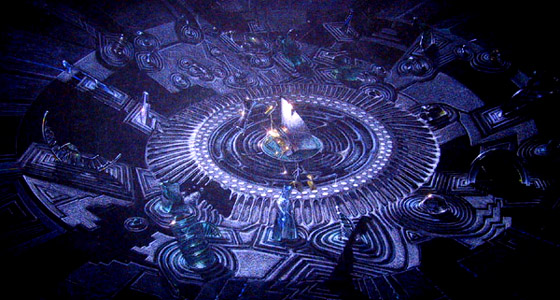It probably wouldn’t shock anyone if you heard that some wingnut dufus said that in public. What’s becoming even more disturbingly acceptable is this particular dufus sits on the House Science Committee. Ethan Seigal does the honors: [Read more…]
It probably wouldn’t shock anyone if you heard that some wingnut dufus said that in public. What’s becoming even more disturbingly acceptable is this particular dufus sits on the House Science Committee. Ethan Seigal does the honors: [Read more…]
We know there’s some weird and rare stellar denizens in the cosmic jungle, galaxies hollowe dinto rungs like giant Ferris Wheels, dark matter pockets, pocean planets and diamond worlds. But it turns out one species of misfit may be way more common than thought. Cannibal stars, sometimes referred to as vampires, that suck the life blood out of their neighbors for a flush of youthful glory and may shape the evolution of future stars and planets: [Read more…]

Voyager after being captured by a machine intelligence and greatly enhanced in Star Trek: The Motion Picture.
After an epic journey by any standard, Voyager 1 is leaving the solar system, forever. And we stand, collectively, on the cusp of being just barely an interstellar species: [Read more…]

Artist's conception of a Jupiter-size rogue planet with the edge on disk of a spiral galaxy in the background. Image via the Wiki
I’ve posted on rogue planets and nomads and even a few wandering worlds that reach incredible speeds. A new study confirms what common sense would tell us: some of these restless worlds end up in alien solar systems: [Read more…]
What with Pluto being demoted and exosolar astronomy going gang busters, a solar system with more planets than our own was bound to turn up sooner or later. New data from a near twin of our sun 130 light-years away has come sooner: [Read more…]
The image above is the globular cluster M54, a huge ball of mostly older stars 90,000 light-years away. I thought I knew about globular clusters, but the Bad Astronomer posted two points that are entirely new to me, and very cool: [Read more…]

Artist's conception of a Jupiter-size rogue planet with the edge on disk of a spiral galaxy in the background. Image via the Wiki
Call it planet Crank. A study slated to be published in the Notices of the Royal Astronomical Society finds that not only are nomad planets possible, under ideal conditions some of them could be ejected from the heart of large galaxies at an appreciable fraction of the speed of light: [Read more…]
The NASA WISE telescope spent a year imaging sections of the sky in infrared and astronomers have been working for the last few months to knit it together in a 360 degree map, all doped up with false color. It is spectacular. The limitations of this website can’t do it justice: that bad boy above is scalable like you wouldn’t believe. (Speaking of which, don’t click on the last image or two if your PC bitches about large pics, one of them is width 54000, which auto scales to 5400 on some devices and still causes fits). Let’s take a little piece of it on the far left and zoom in, so you can see what this means. [Read more…]
Eta Carinae, 7th sun in its constellation, is not your ordinary star, or even a familiar crusty old red-giant. At the heart of the gorgeous double lobed cloud are at least two massive stars, and one of them is one the most unusual kinds of stellar objects in the universe: an unstable, misshapen blue-white colossus that could burst open and shower this section of the galaxy with deadly gamma rays any day. It almost happened once before, in 1843, when the object suddenly became the second brightest star in the sky for a few weeks. What’;s neat is astronomers have now found a way to study that original light, once thought long gone at the speed of 300,000 KM/sec: [Read more…]

CRIRES model-based computer-generated impression of the Plutonian surface, with atmospheric haze, and Charon and the Sun in the sky.
The official budget won’t be released until Monday, but word is NASA’s unmanned program will see big cuts and Mars missions will take the brunt of them. Sadly, when it comes to our budget priorities as of late, we are one screwed-up country: [Read more…]
